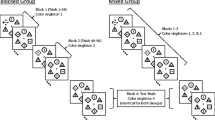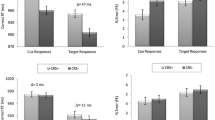Abstract
The goal of the study was to investigate whether task rules are automatically applied to irrelevant distracters. In three experiments, subjects categorized target words which were superimposed on distracter pictures. The categorization rule was arbitrary and the distracters were not relevant at any point during the experiment. We found congruency effects for distracters that belonged to the task-relevant categories, but were never presented as target words. Responses were faster when target and distracter belonged to the same category, i.e., were mapped to the same response, than when they were mapped to different responses. Since the distracters were never responded to in the course of the experiment, interference caused by retrieval of S-R episodes cannot explain the results. Instead, we propose that even arbitrary categorization rules are applied to all suitable stimuli, including distracters. Results are taken as evidence that a currently relevant task rule enhances processing of target-related information thereby increasing interference by task related, but currently irrelevant information.



Similar content being viewed by others
Notes
Note that Dreisbach and Haider (2009) used distracters that were either semantically related (comparable to the target-related distracters used here) or semantically unrelated to the task (but spatially compatible or incompatible with the target) while in our study, all distracters were semantically related to the task (i.e., could be categorized according to the rule) but only some distracters were related to the targets, i.e. also appeared as target words.
References
Ach, N. (2006). On volition (T.Herz, Trans.). (Original work published 1910) Retrieved March 28, 2011, from Univerity of Konstanz, Cognitive Psychology Web site: http://www.uni-konstanz.de/kogpsych/ach.htm.
Cohen-Kdoshay, O., & Meiran, N. (2007). The representation of instructions in working memory leads to autonomous response activation: evidence from the first trials in the flanker paradigm. The Quarterly Journal of Experimental Psychology, 60(8), 1140–1154.
Cohen-Kdoshay, O., & Meiran, N. (2009). The representation of instructions operates like a prepared reflex: flanker compatibility effects found in first trial following S-R instructions. Experimental Psychology, 56(2), 128–133.
Dreisbach, G., & Haider, H. (2008). That’s what task sets are for: shielding against irrelevant information. Psychological Research, 72, 355–361.
Dreisbach, G., & Haider, H. (2009). How task representations guide attention: further evidence for the shielding function of task sets. Journal of Experimental Psychology. Learning, Memory, and Cognition, 35(2), 477–486.
Dreisbach, G., & Wenke, D. (2011). The shielding function of task sets and its relaxation during task switching. Journal of Experimental Psychology. Learning, Memory, and Cognition, 37(6), 1540–1546.
Egner, T., & Hirsch, J. (2005). Cognitive control mechanisms resolve conflict through cortical amplification of task-relevant information. Nature Neuroscience, 8(12), 1784–1790.
Frings, C., Möller, B., & Rothermund, K. (2011). The croaking frog: retrieval of event files can be conceptually mediated (submitted).
Glaser, W. R., & Glaser, M. O. (1989). Context effects in stroop-like word and picture processing. Journal of Experimental Psychology: General, 118(1), 13–42.
Hommel, B. (1998). Event files: evidence for automatic integration of stimulus-response episodes. Visual Cognition, 5(1), 183–216.
Hommel, B. (2000). The prepared reflex—automaticity and control in stimulus-response translation. In S. Monsell & J. Driver (Eds.), Control of cognitive processes: attention and performance XVIII (pp. 247–273). Cambridge: MIT Press.
Jentzsch, I., & Dudschig, C. (2009). Why do we slow down after an error? Mechanisms underlying the effects of posterror slowing. Quarterly Journal of Experimental Psychology, 62(2), 209–218.
Kessler, Y., & Meiran, N. (2010). The reaction-time task-rule congruency effect is not affected by working memory load: further support for the activated long-term memory hypothesis. Psychological Research, 74, 388–399.
Kiesel, A., Wendt, M., & Peters, A. (2007). Task switching: on the origin of response congruency effects. Psychological Research, 71(2), 117–125.
Klauer, K. C., Eder, A. B., Greenwald, A. G., & Abrams, R. L. (2007). Priming of semantic classifications by novel subliminal prime words. Consciousness and Cognition, 16(1), 63–83.
Kunde, W., Kiesel, A., & Hoffmann, J. (2003). Conscious control over the content of unconscious cognition. Cognition, 88, 223–242.
Logan, G. D. (1988). Toward an instance theory of automatization. Psychological Review, 95(4), 492–527.
Meiran, N., & Kessler, Y. (2008). The task rule congruency effect in task switching reflects activated long-term memory. Journal of Experimental Psychology: Human Perception and Performance, 34(1), 137–157.
Meiran, N., Kessler, Y., & Adi-Japha, E. (2008). Control by action representation and input selection (CARIS): a theoretical framework for task switching. Psychological Research, 72, 473–500.
Naccache, L., & Dehaene, S. (2001). Unconscious semantic priming extends to novel unseen stimuli. Cognition, 80(3), 215–229.
Notebaert, W., Houtman, F., Opstal, F. V., Gevers, W., Fias, W., & Verguts, T. (2009). Post-error slowing: an orienting account. Cognition, 111(2), 275–279.
Pratt, J., & McAuliffe, J. (2002). Determining whether attentional control settings are inclusive or exclusive. Perception & Psychophysics, 64(8), 1361–1370.
Remington, R. W., Folk, C. L., & McLean, J. P. (2001). Contingent attentional capture or delayed allocation of attention? Perception & Psychophysics, 63(2), 298–307.
Reynvoet, B., Gevers, W., & Caessens, B. (2005). Unconscious primes activate motor codes through semantics. Journal of Experimental Psychology. Learning, Memory, and Cognition, 31(5), 991–1000.
Smith, M. C., & Magee, L. E. (1980). Tracing the time course of picture-word processing. Journal of Experimental Psychology: General, 109(4), 373–392.
Snodgrass, J. G., & Vanderwart, M. (1980). A standardized set of 260 pictures: norms for name agreement, image agreement, familiarity, and visual complexity. Journal of Experimental Psychology: Human Learning and Memory, 6(2), 174–215.
Sudevan, P., & Taylor, D. A. (1987). The cuing and priming of cognitive operations. Journal of Experimental Psychology: Human Perception and Performance, 13(1), 89–103.
Tryon, W. W. (2001). Evaluating statistical difference, equivalence, and indeterminancy using inferential confidence intervals: an integrated alternative method of conducting null hypothesis statistical tests. Psychological Methods, 6(4), 371–386.
van den Bussche, E., Notebaert, K., & Reynvoet, B. (2009). Masked primes can be genuinely semantically processed: a picture prime study. Experimental Psychology, 56(5), 295–300.
van Opstal, F., de Lange, F. P., & Dehaene, S. (2011). Rapid parallel semantic processing of numbers without awareness. Cognition, 120(1), 136–147.
van Opstal, F., Gevers, W., Osman, M., & Verguts, T. (2010). Unconscious task application. Consciousness and Cognition, 19(4), 999–1006.
Wendt, M., & Kiesel, A. (2008). The impact of stimulus-specific practice and task instructions on response congruency effects between tasks. Psychological Research, 72, 425–432.
Wenke, D., Gaschler, R., & Nattkemper, D. (2007). Instruction-induced feature binding. Psychological Research, 71(1), 92–106.
Woodworth, R. S. (1938). Experimental psychology. New York: Holt, Rinehart and Winston.
Yehene, E., Meiran, N., & Soroker, N. (2005). Task alternation cost without task alternation: measuring intentionality. Neuropsychologia, 43(13), 1858–1869.
Acknowledgments
We would like to thank Barbara Kamola, Julia Fritz, Veronika Weiß and Lisa Raith for data collection. This research was sponsored by a grant to the second author from the Deutsche Forschungsgemeinschaft (DFG: DR 392/5-2).
Author information
Authors and Affiliations
Corresponding author
Rights and permissions
About this article
Cite this article
Reisenauer, R., Dreisbach, G. The impact of task rules on distracter processing: automatic categorization of irrelevant stimuli. Psychological Research 77, 128–138 (2013). https://doi.org/10.1007/s00426-012-0413-4
Received:
Accepted:
Published:
Issue Date:
DOI: https://doi.org/10.1007/s00426-012-0413-4




